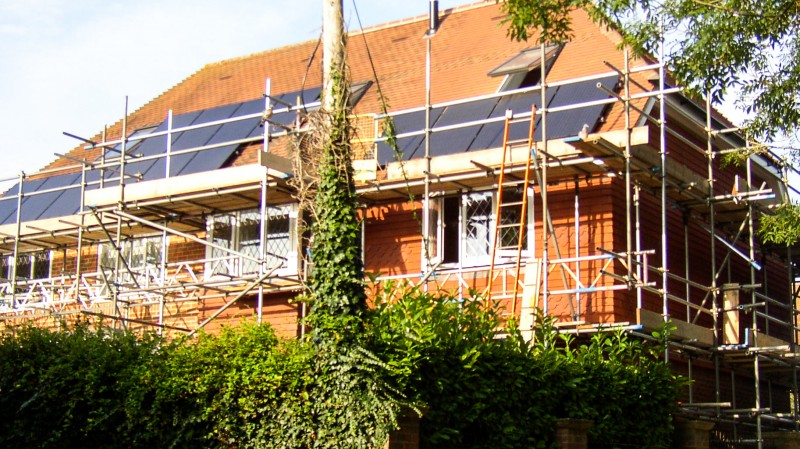You are here: Saving the planet while getting a loft conversion
If you’re already splashing out on a loft conversion, you might consider fitting solar panels to the roof at the same time. You can save money by not hiring scaffolding twice – and avoid double disruption. It is also a very effective way to make your life a little bit greener. But does it pay off?
Installing solar panels
Photovoltaic panels convert the sun’s energy into electricity, which can power your home and – when you aren’t using as much as you’re generating – be fed back into the national grid.
Homes supplying the grid used to be eligible for payments under what was known as the Feed-in Tariff, which was administered by the Department for Business, Energy and Industrial Strategy. This is closed to new applicants but, since January 2020, energy providers with more than 150,000 subscribers have been liable to make similar payments (the exact amounts are up to them) to self-generating customers under the Smart Export Guarantee.
Planning permission shouldn’t be an issue for most homes, as solar installations are covered by what is known as permitted development. However, if you have already made significant changes to your home, or you live in a listed building or conservation area, you may find the permitted development regulations don’t apply. As ever, check with your local authority before you spend any money.

Will they pay for themselves?
With all the investment, will the panels pay for themselves? The answer is not necessarily. It’s important to approach an installation with your eyes open. Panel prices have fallen dramatically, but they still aren’t an impulse purchase, and the return might not be much better than break-even.
The Energy Saving Trust has a handy online calculator, which balances solar’s installation and maintenance costs against the potential lifetime benefit. We used it to calculate the return on a typical installation on a south-facing roof in the south of England. Estimated installation costs ran to £5,419 and delivered a potential lifetime CO2 saving of 19,490 kg, which would offset three and a bit return flights from London to Sydney – so long as you flew economy. Add an extra £1,450 for expected maintenance costs and, if you were only home in the evenings, you’d make an overall loss of £2,359 over the system’s 25-year lifespan.
You would only offset the installation and maintenance cost if you were home – and so using your own electricity – all day long, in which case your potential lifetime benefit would run to £102. If you sold the house before you had extracted the total benefit, your chance of fully offsetting your costs would be further reduced unless the solar cells also managed to increase the sale price, which is by no means guaranteed. Taking panels with you when you move isn’t always practical, either, as they are often designed to fit your existing roof and to maximise solar capture in that position.
Repeat the maths for a property in Edinburgh and the same calculator projects an overall lifetime loss of £369. If your Edinburgh roof is facing north, the news is even worse: a loss of £1,873. You may, however, be eligible for a loan from Home Energy Scotland to help finance the installation.
Should I install solar panels?
But let’s not downplay the benefits of solar panels. Any reduction you can make to your carbon footprint is worthwhile, and panels can play an important part in minimising your environmental impact. They also have the potential to secure your energy supply when your neighbours are suffering outages. If installing at the same time as your loft is being converted means you can save on scaffolding rental, even better, as your installation costs will be lower and the breakeven point will come sooner.
Don’t write off solar on the calculations, above. Every property is unique, you may well earn more than predicted under the Smart Export Guarantee, and you could make savings on the capital costs, too, if you keep your eyes peeled for offers and subsidies. However, approaching a project like this from a purely financial perspective would be a mistake.
If you have found your forever home, installing solar panels today means you will enjoy their benefits for years to come. You will make ongoing savings on your energy bills and, more importantly, feel a warm glow inside – not from cheaper heating, but the knowledge that you are helping make the world a little bit greener.
If you are looking for help with any electrical issues, you may find some of these services useful:
Electricians
Get contact details for Electricians near to you. View the Feedback from other Customers to help you make an informed choice.
Electrical Reports
Find an Electrician to produce an Electrical report (sometimes known as an Electrical Installation Condition Report - or EICR) for a property.
Smart Home Technology
If you are looking for an Electrician to help with Smart Home Technology
Kitchen / Bathroom Electrics
If you are looking for an Electrician to help with Kitchen or Bathroom Electrics
LED Lighting
If you are looking for an Electrician to help with LED Lighting
Electric Heating Installation
If you are looking for an Electrician to install Electric Heating
Electric Vehicle Charging Point Installation
If you are looking for an Electrician to install an Electric Vehicle Charging Point
Security and Fire Alarms
If you need a fire or security alarm installing